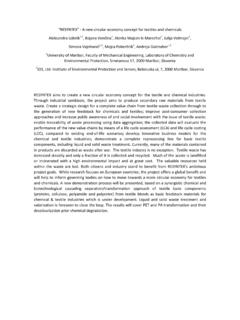Transcription of The textile and clothing Industry: Adjusting to the post ...
1 183 The textile and clothing industry : Adjusting to thepost-quota worldRatnakar Adhikari and Yumiko Yamamoto*1. Introduction It is just over two years since the phasing-out of the global system of quotacontrols which governed trade in the textile and clothing (T&C) industry generates US$479 billion in world exports and accounts for per cent share in global merchandise exports [World Trade Organization(WTO, 2006a)]. The quota system and policy developments since its demiseillustrate the highly selective and targeted nature of production and marketrelations in the industry .
2 Although 1 January 2005 was supposed to markthe end of the quota system for all countries and was expected to unleashmassive adjustment challenges for a number of countries, quota eliminationhas shown a mixed result so far. Moreover, countries that have lost out themost had seen their exports decline earlier, which means that their dismalperformance cannot merely be ascribed to the quota phase-out. Several countries that had been projected by numerous studies to loseout in the post-quota world not only managed to hold on to their past gains,but also achieved significant growth in their export earnings.
3 This is mainlybecause of the re-imposition of quotas on T&C exports from China not onlyby the developed countries but also by some developing countries whichwere making use of temporary safeguard measures as agreed to by China dur-ing the process of its accession to the WTO. Most analysts predict that the situation will not remain the same afterthe phasing-out of the safeguards measures, which will expire in 2008. At thesame time, the entry of Vietnam into the WTO from 11 January 2007,which enables the country to compete in the global T&C market withoutany quantitative restrictions on T&C exports, means that the competitivepressure is likely to become intense for the small and marginal , the real adjustment challenge is yet to begin.
4 textiles and clothing is a unique industry in the global economy main-ly for three reasons. First, most developed countries of today and newlyindustrialized countries (NICs) used this industry as the springboard fortheir development journey and even some least developed countries (LDCs)* Programme Specialist, UNDP Regional Centre in Colombo (RCC), Asia-Pacific Trade& Investment Initiative (APTII), and Gender and Trade Programme Advisor, UNDPRCC APTII, respectively.
5 The opinions expressed in this document are those of theauthors and do not necessarily reflect those of the United Nations DevelopmentProgramme (UNDP). 184 Industrial Development for the 21st Centurywere able to step onto the development ladder on the basis of their T&Cindustry. Millions of people, mostly women, are employed in this industryin these economies. Second, this industry has very low entry barriers; entrydoes not require huge capital outlay and factories can be set up with workerswith relatively low skills.
6 Therefore, this industry is characterized by highcompetition intensity. Third, this industry is the most protected of all man-ufacturing industries in the global economy , both in developed and develop-ing countries. Protectionist interests have been extremely ingenious in creat-ing new protectionist instruments in the past 50 years. Taking as precedent the imposition in 1957 of voluntary export restraints(VER) on the exports of cotton textiles from Japan to appease the domestictextile industry in the United States, the regime of protection in this industrywas institutionalized in 1974 with the introduction of the Multi-FibreArrangement (MFA).
7 This governed international trade in textiles and cloth-ing for almost two decades. This arrangement enabled developed countries tobilaterally negotiate quotas with supplier countries taking into account theircompetitiveness and the perceived threat to the domestic interests in theimporting countries. During the Uruguay Round of multilateral trade nego-tiations (1986-93), the international community decided to integrate theMFA into the new Agreement on textiles and clothing (ATC), which fea-tured a clear time table for phasing-out the quota system within a ten-yearperiod starting on 1 January 1995 (Adhikari and Weeratunge, forthcoming).
8 Even during the heyday of the quota system, characterized by a distort-ed global market for T&C products, entrepreneurs in countries restricted byquotas found ways to exploit the system. They established factories in coun-tries with low levels of quota utilization and in some instances even helpedin the industrialization process of those countries. For example, Korean com-panies established factories in Bangladesh, Caribbean and Sub-SaharanAfrica, Chinese companies established factories in several Asian and Africanlocations, Indian companies in Nepal and even relatively minor players inthe global market such as Sri Lankan and Mauritian businesspersons estab-lished factories in the Maldives and Madagascar, respectively, to overcomequota restrictions.
9 While the indigenization of this industry took place insome countries ( , Bangladesh, Nepal) due to the entry of the local entre-preneurs, in other countries ( , Maldives) the industry itself got wiped offthe industrial map once the foreign investors pulled out. Against this backdrop, the objective of this paper is to discuss the cur-rent state of play in the global T&C market, identify the factors shaping andinfluencing the evolution of this industry including emerging trends, andprovide some policy recommendations for the developing countries to helpthem not only to survive in the post-quota regime, but also to exploit theopportunities created by the increased competition in the industry .
10 The remainder of the paper is organized as follows. Section 2 summa-rizes the trade flows in the post-quota world and discusses the human devel-185 The textile and clothing Industryopment implications of the quota phase-out. Section 3 discusses challengesfacing developing countries and LDCs in using the T&C industry as aspringboard for their development efforts. Section 4 deals with emergingissues in the areas of T&C trade at the global level, which offers variousopportunities as well as challenges to the T&C industry in the developingcountries.



















